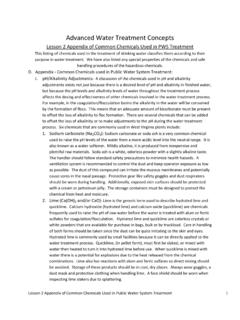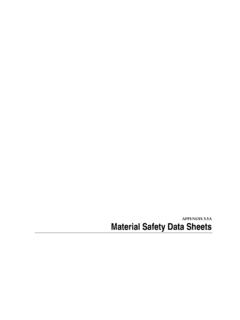Transcription of Appendix D—Agriculture Pathogen Biosafety
1 Appendix D: agriculture Pathogen Biosafety 343 Appendix D agriculture Pathogen BiosafetyThe contents of this Appendix were provided by USDA. All questions regarding its contents should be forwarded to the IntroductionII. BSL-3-AgIII. BSL-3, EnhancedIV. pathogens of Veterinary SignificanceV. Summaries of Selected agriculture AgentsVI. Additional informationI. IntroductionRisk assessment and management guidelines for agriculture differ from human public health standards. Risk management for agriculture research is based on the potential economic impact of animal and plant morbidity, and mortality, and the trade implications of disease.
2 Agricultural guidelines take this difference into account. Worker protection is important but great emphasis is placed on reducing the risk of agent escape into the environment. This Appendix describes the facility parameters and work practices of what has come to be known as BSL-3-Ag. BSL-3-Ag is unique to agriculture because of the necessity to protect the environment from an economic, high risk Pathogen in a situation where studies are conducted employing large agricultural animals or other similar situations in which the facility barriers now serve as primary containment. Also described are some of the enhancements beyond BSL-3 that may be required by USDA/APHIS when working in the laboratory or vivarium with veterinary agents of concern.
3 This Appendix provides guidance and is not regulatory nor is it meant to describe policy. Conditions for approval to work with specific agricultural agents are provided at the time USDA/APHIS permits a location to work with an BSL-3-Ag for Work with Loose-housed AnimalsIn agriculture , special biocontainment features are required for certain types of research involving high consequence livestock pathogens in animal species or other research where the room provides the primary containment. To support such research, USDA has developed a special facility designed, constructed and operated at a unique animal containment level called BSL-3-Ag.
4 Using the containment features of the standard ABSL-3 facility as a starting point, BSL-3-Ag facilities are specifically designed to protect the environment by including almost all of the features ordinarily used for BSL-4 facilities as enhancements. All BSL-3-Ag containment spaces must be designed, constructed and certified as primary containment Biosafety in Microbiological and Biomedical LaboratoriesThe BSL-3-Ag facility can be a separate building, but more often, it is an isolated zone within a facility operating at a lower Biosafety level, usually at BSL-3. This isolated zone has strictly controlled access with special physical security measures and functions on the box within a box principle.
5 All BSL-3-Ag facilities that cannot readily house animals in primary containment devices require the features for an ABSL-3 facility with the following enhancements typical of BSL-4 facilities:1. Personnel change and shower rooms that provide for the separation of laboratory clothing from animal facility clothing and that control access to the containment spaces. The facility is arranged so that personnel ingress and egress are only through a series of rooms consisting of: a ventilated vestibule with compressible gaskets on the two doors, a clean change room outside containment, a shower room at the non-containment/containment boundary, and a dirty change room within containment.
6 Complete animal facility clothing (including undergarments, pants and shirts or jump suits, and shoes and gloves) is typically provided in the dirty change room, and put on by personnel before entering the research areas. In some facilities, complete animal facility clothing and personal protective equipment are provided in the clean change room, where they can be stored and stowed for use without entry into containment. When leaving a BSL-3-Ag animal space that acts as the primary barrier and that contains large volumes of aerosols containing highly infectious agents (an animal room, necropsy room, carcass disposal area, contaminated corridor, etc.)
7 , personnel usually would be required to remove dirty lab clothing, take a shower, and put on clean lab clothing immediately after leaving this high risk animal space and before going to any other part of the BSL-Ag facility. When leaving the facility, these personnel would take another shower at the access control shower and put on their street clothing. Soiled clothing worn in a BSL-3-Ag space is autoclaved before being laundered. Personnel moving from one space within containment to another will follow the practices and procedures described in the Biosafety manual specifically developed for the particular facility and adopted by the laboratory Access doors are self closing and lockable.
8 Emergency exit doors are provided, but are locked on the outside against unauthorized use. The architect or engineer shall consider the practicality of providing vestibules at emergency Supplies, materials and equipment enter the BSL-3-Ag space only through an airlock, fumigation chamber, an interlocked and double-door autoclave or shower. Appendix D: agriculture Pathogen Biosafety 3454. Double-door autoclaves engineered with bioseals are provided to decontaminate laboratory waste passing out of the containment area. The double doors of the autoclaves must be interlocked so that the outer door can be opened only after the completion of the sterilizing cycle, and to prevent the simultaneous opening of both doors.
9 All double door autoclaves are situated through an exterior wall of the containment area, with the autoclave unit forming an airtight seal with the barrier wall and the bulk of the autoclave situated outside the containment space so that autoclave maintenance can be performed conveniently. A gas sterilizer, a pass-through liquid dunk tank, or a cold gas decontamination chamber must be provided for the safe removal of materials and equipment that are steam or heat sensitive. Disposable materials must be decontaminated through autoclaving or other validated decontamination method followed by Dedicated, single pass, directional, and pressure gradient ventilation systems must be used.
10 All BSL-3-Ag facilities have independent air supply and exhaust systems that are operated to provide directional airflow and a negative air pressure within the containment space. The directional airflow within the containment spaces moves from areas of least hazard potential toward areas of greatest hazard potential. A visible means of displaying pressure differentials is provided. The pressure differential display/gauge can be seen inside and outside of the containment space, and an alarm sounds when the preset pressure differential is not maintained. The air supply and exhaust systems must be interlocked to prevent reversal of the directional airflow and positive pressurization of containment spaces in the event of an exhaust system Supply and exhaust air to and from the containment space is HEPA filtered.













